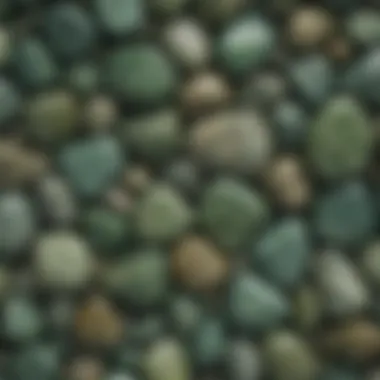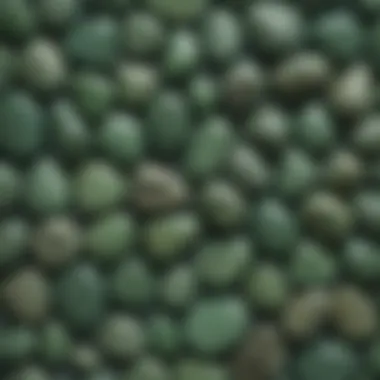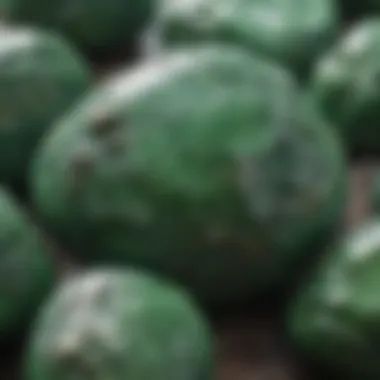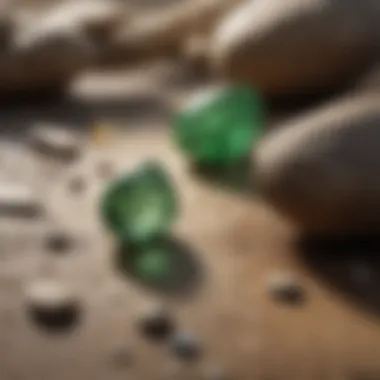Mastering the Identification of Opaque Green Stones


Intro
Understanding opaque green stones provides not only aesthetic value but also insight into geological processes. As collectors pursue these captivating stones, their identification becomes crucial. Opaque green stones exhibit unique traits that set them apart from other varieties. Recognizing the characteristics and classifications aids in both appreciation and collection efforts.
Rock and Fossil Identification
Types of Opaque Green Stones
Common forms of opaque green stones include jade, serpentine, and malachite. Collectors should familiarize themselves with these broader categories:
- Jade: Renowned for its toughness and rich green color, often utilized in jewelry.
- Serpentine: This stone can range from light to dark green and is easily confused with jade.
- Malachite: Notable for its banded patterns and lighter hue.
Each of these types has unique formations and chemical properties, marking their significance in any geological collection.
Characteristics to Look For
When identifying a stone, its attributes play a critical role. One should observe several characteristics:
- Color Variation: Assess the depth of green. Richer tones often indicate higher quality.
- Texture: Examine the smoothness and any reflective properties.
- Density: Weigh the stone; heavier specimens suggest higher mineral content.
Combining these elements allows for reliable identification.
Tools for Identification
Before diving into rock collecting, equip yourself with essential tools to discern subtle differences. Items like:
- Hand lens for zooming in on small details
- Scratch test kit for determining hardness
- Access database or handbook for comparison
can elevate the identification process and enhance accuracy.
Collecting Tips and Techniques
Prospective collectors must understand the etiquette and strategy of gathering stones effectively. Cementing good habits is vital for positive experiences.
Best Practices for Collecting
Select ethical harvesting since many locations have restrictions. When gathering stones, follow these points:
- Acquire permission if on private lands or reserves.
- Use proper tools to minimize damage to the site.
- Take only what you need, leaving the environment cared for.
Locating Prime Collecting Sites
The prime locations for opaque green stones can be anywhere from rocky riverbeds to mountainous regions. To enhance your chances, assess:
- Local geological maps available through geological agencies.
- Online forums such as Reddit for recent findings from fellow enthusiasts.
How to Safely Extract Specimens
Collecting stones involves careful extraction methods:
- Carry a hammer for breaking tough surfaces.
- Be certain to wear safety goggles for protection.
- Clean your finds gently without using harsh chemicals.
Preservation and Display
Proper care prolongs the beauty of collected opaque green stones.
Techniques for Preserving Rocks
Before showcasing, wash stones with water and a soft brush. Avoid acidic environments that can erode their condition. For sustained beauty, apply mineral oil sparingly.
Proper Storage Methods
Labels or tags with origins, types, and notes make identification easier later. Store in expensive containers or plush bags to prevent scratches or damages.
Creative Display Ideas


Design a casing or shadowbox as artistic showcases. This can involve layering backgrounds to contrast each stone display effectively.
Geological Insights
Understanding the geological significance of opaque green stones enriches one's knowledge base.
Geological Formations and Processes
Opaque green stones may form in metamorphic or sedimentary rock environments. Each formation process offers stories about earth's historical timeline.
Historical Significance of Rocks
Some stones reflect cultural histories, like jade which has been valued in Asian cultures for thousands of years.
Notable Discoveries in the Field
Researching significant locations or findings can enhance appreciation for these stones. Knowledge shared on platforms such as Facebook groups or Reddit threads helps maintain discussions in the community. > **
Understanding Opaque Green Stones
Understanding opaque green stones is a crucial aspect for both new and seasoned rock collectors. These stones possess unique characteristics that make their identification both interesting and rewarding. This section sets the groundwork for evaluating opaque green stones by introducing relevant principles relating to material properties and geological significance.
Defining Opaqueness
Opaqueness refers to the quality of a material that does not allow light to pass through. In the context of gemstones, opaque materials differ significantly from translucent or transparent ones. For opaque green stones, their non-translucent nature often adds depth to their color but makes identification more complex. Collectors must closely observe the texture, luster, and other physical characteristics, as these factors play a significant role in determining the stone's identity. Not all green stones are opaque; therefore, accurately defining this aspect is essential to differentiate between various types effectively.
The Color Green in Geology
Green stones arise from a variety of geologic processes. The presence of specific minerals defines their green color. For instance, the most common reason for green hues in rocks is dissolved iron. Significant minerals like olivine, epidote, and chlorite contribute to the formation of various green stones. Understanding the geological background enhances the identification process.
- Olivine is a magnesium-iron silicate often found in volcanic rocks.
- Epidote generally emerges from metamorphic transformation.
- Chlorite forms primarily from alteration of mafic minerals.
The implications of these mineral associations are noteworthy. For example, the environmental conditions and geological setting can dictate the green color intensity and texture. As a result, distinguishing various opaque green stones involves a nuanced understanding of both geological contexts and mineral compositions that construct individual stone identities.
For rock and fossil collectors, mastery of this knowledge elevates the craft of stone recognition into an art.
Physical Characteristics
Understanding the physical characteristics of opaque green stones is fundamental for anyone interested in identification. These characteristics help distinguish one type of stone from another. Knowing about textures, luster, surface finish, weight, and density enhances the collector's ability to correctly identify and appreciate these unique geological materials.
Common Textures
The texture of a stone can tell a lot about its origin and composition. Opaque green stones exhibit an array of textures that may range from smooth and glossy to rough and uneven. For example, jade often presents as a smooth surface, indicating it has gone through a lapping process. On the other hand, malachite may show a fibrous or granular texture due to its formation process. Recognizing these textures helps collectors avoid misidentification and ensures a more accurate understanding of the stone's properties.
Luster and Surface Finish
Luster provides insights into a stone’s intrinsic characteristics. Opaque green stones may present different types of luster, such as vitreous, waxy, or dull. For instance, chrysoprase tends to have a waxy finish, contributing to its distinctive appeal. Surface finish can also indicate the presence of treatments that may have enhanced the stone's appeal. Identify whether the stone has been polished or left in its natural state, which can be crucial for understanding its value and authenticity.
Weight and Density Considerations
Weight and density play significant roles in identifying opaque green stones. Each type of stone can be weighed to confirm its identity or to distinguish similarly colored stones. For example, serpentine is generally less dense than jade, which can make a significant difference during the identification process. Keep in mind that the weight of a stone can also vary depending on moisture, so it's advisable to weigh stones when they are dry. Understanding how weight and density influence identification can lead to more precise assessments.
Recognizing the physical characteristics of opaque green stones is a foundational skill for any serious collector. It allows for informed choices when evaluating new finds, ensuring each piece fits into the collector's aspirations and needs.
Common Varieties of Opaque Green Stones
Understanding the common varieties of opaque green stones is a critical aspect of identifying these unique specimens. Each variety carries its own distinct characteristics and significance in the realm of geology and collection. For rock and fossil collectors, being aware of the various types, their properties, and their appearances not only enhances the collecting experience but also aids in accurate identification. The appeal of opaque green stones lies in their rich colors and textures. This section outlines several key varieties worth noting.
Jade and Its Variants
Jade is perhaps the most renowned of the opaque green stones, historically treasured in many cultures for its beauty and purported metaphysical numbers. Two primary types exist: jadeite and nephrite, both playing essential roles in diverse artisanal crafts.
- Jadeite possesses a glossy finish and vibrant coloration, with its hues varying from pale green to intensely dark tones. Due to its rarity, jadeite often fetches higher prices in the market compared to nephrite.
- Nephrite, on the other hand, is generally more attainable. Its textures lend a softer and slightly waxy feel. Nephrite tends to fall in a more muted color range, yet still exhibits lovely shades of green.
Recognizing the differences between these variants requires not only visual scrutiny but an understanding of their historical significance and cultural context.


Serpentine and Its Characteristics
Serpentine constitutes another prominent opaque green stone, appreciated for its soft structure. Its color ranges from light to deep green. This stone is not as well-known as jade, yet its appeal lies in its unique veining and often mottled appearance.
Common features of serpentine include:
- Texture: Typically smooth or slightly waxy.
- Luster: Generally dull or satin-like, making it distinct from the higher shine of jadeite.
- Chemical Composition: This stone is comprised primarily of magnesium and silicate.
Serpentine is less expensive than jade varieties, making it appealing to collectors at various levels. Being relatively soft, it lends itself well to carving, which adds to its attraction.
Chrysoprase Overview
Chrysoprase offers an exquisite yet different example of opaque green stones. Unlike other varieties, it is a chalcedony, giving it a dense, glassy texture rather than a conventional jade feel. The vibrant apple-green shade typically has translucence, setting it apart.
Notable features include:
- Unique Green Hue: Often more vivid than other green stones.
- Play of Color: Can exhibit faint color play under certain light conditions, increasing its allure.
Chrysoprase is valued not just for its beauty but also for its historical associations and perceived metaphysical properties, linking collectors to different cultural histories.
Malachite Identification
Malachite provides an easily identifiable variety among opaque green stones. Its distinctive deep green color combined with unique banding patterns offers clear identify marks. The surface is often polished to a glassy finish that enhances its aesthetic appeal.
Key Identification Tips:
- Look for striking banding; a defining feature of malachite.
- Observe any light texture differences; malachite tends to have a soft and smooth surface.
- Consider conducting chemical tests, as malachite reacts differently due to its copper content.
Overall, malachite’s dynamic patterns contribute not only to its beauty but also to its value in the collector's market.
Green Quartz Variations
Green quartz includes several specific types of stones characterized by their distinct green tones and appearance. Ranging from pale mint to rich forest green, these variations can successfully mislead less-experienced collectors.
Examples include:
- Prasiolite: Often described by its more vibrant hues, ranging from yellowish-green to light olive.
- Green aventurine: Known for glistening due to the presence of mica particles; has a more muted structure compared to prasiolite.
The recognition of unique features is crucial, as varying optics or impurities frequently lead to confusion in differentiation from gemstones.
Identifying opaque green stones requires an attentive approach. Knowledge of specific variants and their distinct properties play a significant role in accurate classification and ultimately pursuing a meaningful acquisition for any collection.
Identification Techniques
Understanding the right identification techniques is crucial when it comes to opaque green stones. Each stone holds distinct characteristics that require precise methods for accurate identification. Whether for personal collections or academic pursuits, these techniques enable enthusiasts to distinguish between the varieties efficiently, distinguishing valuable specimens from common imitations. Moreover, the nature of opaque stones makes detailed analysis even more necessary. Therefore, employing systematic approaches helps ensure that identifications are based on solid evidence rather than assumptions.
Visual Examination
Visual examination is often the first step in the identification process. This approach requires keen attention to detail. Each characteristic under natural light can provide immediate clues. When examining an opaque green stone, take note of the following:
- Color Variations: Not all opaque green stones share the same hue. Assess the shade. It can range from deep forest green to lighter mint tones.
- Patterns and Inclusions: Observe any tell-tale patterns, speckles, or veins, which may point toward specific minerals.
Do not forget lighting conditions. Natural light is preferable for a more accurate color assessment. A bright light or flashlight may create misleading reflections. Just ensure that whatever condition you use is consistent.
Use of Magnification Tools
Magnification tools provide added clarity when identifying specific features in opaque green stones. A simple 10x jeweler's loupe is often sufficient for initial observations.
The benefits include:
- Inclusions: Much information may lie within tiny bubbles or pigments. Magnification brings them into focus for closer studies.
- Surface Details: Identifying scratches, pits, or residues can hint at previous treatment or handling of the stone.
When inspecting the stone, position it against a contrast background. This aids in focusing on intricate features. Subtle differences that surprise may appear under magnification, showing the complex reality of these stones.
Conductivity Tests


Conductivity tests enable a scientific approach to stone identification. The principle involves measuring how well a stone conducts electricity. Different minerals offer varied conductivity patterns.
To conduct a simple test, place the stone gently against two electrodes. Measure the readings:
- Jade typically exhibits high conductivity.
- Serpentine, on the other hand, usually shows lower conductivity levels.
Understanding which stones conduct electricity can be a fundamental element in distinguishing one type from another. However, be cautious not to apply excessive force that may alter the state of the stone or potentially cause damage.
Acid Reaction Tests
Acid reaction tests present an additional dimension in identifying opaque green stones. For instance, when a drop of hydrochloric acid touches certain minerals, a reaction can offer helpful insights.
For example, if the stone bubbles, it often indicates calcite presence. Conversely, brands not showing any effervescence might belong to a different category. To run this test securely:
- Use a glass dropper to place one to two drops onto the stone.
- Take safety precautions. Always wear gloves and goggles to ensure safety.
Keep in mind that the interaction of acid can damage some stones. Conduct analyses wisely, focusing solely on small areas each time.
Employing these identification techniques not only reveals the structures of opaque green stones but also elevates the overall understanding of their properties."
Common Misidentifications
Opaqueness in green stones can lead to significant misidentifications, causing misunderstandings not only about their true nature but also about their value and use. Misidentifying green stones can have major consequences for collectors. For example, a high-quality natural stone could be mistaken for a low-quality synthetic counterpart. Recognizing potential mistakes in identification is essential for anyone involved in geology, collection, or simply appreciation of these stones. A prudent approach ensures clarity and value preservation in collections.
Identifying Fake Stones
Key Indicators of Fake Stones:
- Surface Feel: A true stone often feels cooler and has a more substantial weight compared to a fake.
- Reflections: Observe the light reflections which may show distinct differences in quality.
- Inclusions: Genuine stones usually display inclusions and irregularities while fakes tend to have a uniform and perfect appearance.
By utilizing the appropriate tools and experience in observing these features, individuals can enhance their success in recognizing real stones.
Differentiating Natural from Synthetic
The challenge of differentiating natural green stones from synthetic versions sheds light on another vital consideration. Synthetic stones, often artificially crafted with precise conditions, may appear immaculate and desirable at first glance, but they lack the unique story behind each natural specimen.
Considerations to Differentiate:
- Formation Patterns: Examine growth patterns with a magnifying lens. Natural stones present varied patterns while synthetic stones may appear more uniform.
- Chemical Composition: Conduct tests to check for chemical properties that may reveal its true origin, which can be easily identifiable with detailed analysis in a lab.
Being informed in these aspects enrich the collector’s knowledge, informing through stages from casual interested view to adept expert perspective on stones.
Confusion with Other Minerals
Confusion can also arise when opaque green stones are similar in appearance to various other minerals. Familiarity with common characteristics can aid significantly in steering clear of misidentification and misunderstandings.
Common Minerals for Misidentification:
- Serpentine: This mineral often exhibits an intense green color, which can parallel typical jade hues.
- Chrysoprase: Despite being a variety of quartz, its vibrant color may easily cause confusion if not examined closely.
- Tremolite: Often presenting green shades somewhat similar to jade, its identification largely requires strategic examination.
Differentiating these similar appearing minerals requires meticulous observation and application of various identification techniques.
"Understanding the differences between genuine materials and their imitations gives collectors better confidence, enhancing their collection and analytical skillset."
By being aware of the hidden pitfalls in identification, collectors of opaque green stones not only avoid common mistakes but also gain deeper insight into their collections.
Enlightened examination can reveal more than just stone type; it can uncover historical storytelling echoed in natural formations.
Ending
Key elements include:
- Familiarizing oneself with various physical characteristics of the stones.
- Learning about common varieties such as jade, malachite, and serpentine.
- Understanding identification techniques that incorporate visual examinations and tests.
The benefits of a systematic approach in identification are substantial. It allows collectors to avoid common misidentifications and, ultimately, appreciate the true value of their collections. When collectors can confidently discern synthetic from natural stones, they ensure the maintenance of both integrity and value in their collections.
Moreover, recognizing the differences among similar-looking minerals can not only enhance the value of a collection but can also lead to a deeper appreciation of geology itself. Understanding the nuances and specific characteristics offers a more enriched experience for the collector. Therefore, dedicating time and resources to learn about opaque green stones deserves consideration, ensuring that hobbyists become astute connoisseurs within the geological community.
"Knowledge in identification creates a bond between the collector and the geological marvels they acquire."
In summary, this article seeks to equip you with knowledge and tools, guiding you through the intricate journey of identifying opaque green stones, ultimately enriching your experience in this fascinating field.







